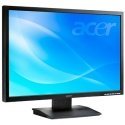Difference Between TFT and LCD
TFT vs LCD
Liquid Crystal Displays or LCDs were created as an alternative to big and bulky CRT displays. They were energy efficient, thin, and light. But problems plagued earlier LCD models and made them far too inferior to CRT displays. As a remedy, traditional LCD construction methods were adapted to improve the performance of these diplays. TFT or Thin Film Transistor was the solution they found. Instead of the traditional method of producing silicon transistors in wafers, TFT elements are deposited directly to the glass substrate.
The new method of producing the screen had a few immediate improvements. TFT made it possible to reduce the crosstalk between individual pixels resulting in a significant improvement in image quality. Crosstalk is when the signal of adjacent pixels affect the operation of the pixel. This deviates the brightness of pixels, making it brighter or dimmer than it was intended to be. TFT also solved, or at least minimized, the inherent problem of LCD that made it unusable for a lot of applications. LCD screens used to have a very high response time and it was not capable of reproducing fast motion. This problem made gaming and watching movies on these displays pretty terrible. The small transistor elements in a TFT display requires a smaller amount of charge to change its state. The lower charge needed translates directly to a faster response time. As development continued on TFT displays, the response time became lower and lower until LCDs were almost competitive with CRTs with respect to response time.
TFT was so successful that it became the standard in producing LCD screens. Today, all the LCDs being made are built with TFT. Even the newer screens being developed that use LEDs still utilize a TFT layer to drive the display. TFT might be totally replaced in the future by a superior technology but for now, it is the dominant element in all LCDs.
Summary:
1.LCD is a class of displays that uses transistors to create an image while TFT is one of the methods of creating an LCD
2.Instead of the traditional semiconductor creation process, TFT elements are directly deposited into a substrate that is usually made of glass
3.Displays made with TFT produces better images and are less prone to crosstalk compared to traditional LCD
4.TFT elements require a smaller amount of charge to activate allowing faster screen redraws
5.All LCD displays being produced today are now made with TFT
- Difference Between Sony Cybershot S Series and W Series - December 22, 2012
- Difference Between Samsung Galaxy S3 and iPhone 5 - December 21, 2012
- Difference Between Samsung Galaxy S2 (Galaxy S II) and Galaxy S 4G - December 20, 2012
Search DifferenceBetween.net :
9 Comments
Trackbacks
- Difference Between Nikon D80 and Nikon D90 | Difference Between | Nikon D80 vs Nikon D90
- Difference Between DVI and Analog | Difference Between | DVI vs Analog
- Difference Between Canon Rebel XT and Canon Rebel XTi | Difference Between | Canon Rebel XT vs Canon Rebel XTi
- Difference Between DVI and RGB | Difference Between | DVI vs RGB


The post says “5.All LCD displays being produced today are now made with TFT”
But what is today since the post doens”t have a date!
is it possible to transform my tft screen to lcd or led?
Can you change my EGA to a LCD? I am thinking of inventing a magical conversion kit for EGA to LCD monitors. It will make millions!
This doesn’t explain anything. In fact, I’m about 40% sure you’re taking a simple and complicating it with opinionated and unfinished explanations
How can i make logo in my sing sung LCD TV?